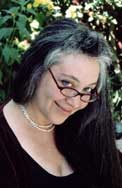 |
||||
|
||||
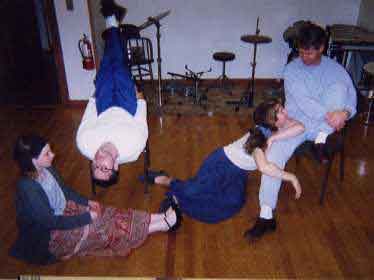 |
||||
| (Yankee) Dada Dollhouse Doodles Actors’ Training Project End-of-Term Recital Tuesday, April 25, 2000 |
||||
| By Lissa Tyler Renaud, Ph.D. | ||||
|
||||
| The End-of-Term Recital Series serves to provide all students connected to the Actors’ Training Project with an opportunity to put new skills into practice under professional conditions in the presence of colleagues and the like-minded. The Recitals are formal in the sense that you are presenting the most polished possible version of each piece you do, for the purposes of 1) dignifying your efforts to master something difficult, and 2) gaining performance experience towards making or enriching your future contribution to the performing arts professions. The Recitals are informal, though, in several senses. For example, they take place in our usual classroom, mostly making use of what’s there for sets. They are not advertised to the paying public; they are not frequented by agents. Videotaping is done strictly a là "home movies." Finally, a certain amount of loopy humor (mirth, levity) is in evidence to help us celebrate a term well done. Since the Recitals typically take place three times a year, each one concluding four months of continuous work for the group students, the occasions are designed to be both educational (look what we can do!) and festive (we did it!). So, welcome! Pull up a chair; you’ll find a full program at the end of this "virtual presentation." You are here: |
||||
 |
||||
| (Yankee) Dada Dollhouse Doodles Actors’ Training Project End-of-Term Recital Tuesday, April 25, 2000 |
||||
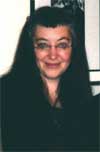 |
Welcome to the Actors’ Training Project’s End-of-Term I/2000 In-Class Recital and Gala Celebration. Our program tonight is entitled "(Yankee) Dada Dollhouse Doodles." The "Yankee" is for the fact that we are Americans performing mostly European material. The "Dada" is for the avant-garde and experimental approaches we investigated this term. The "Dollhouse" is for the name of the Ibsen play we’ve been working on for some time now. "Doodles" is to reflect the thinking-out-loud nature of what we’re going to show you tonight. Thus: Yankee Dada Dollhouse Doodles. And lest I leave you with the impression that coming to this title was an entirely “logical” process--it’s also the title because…it sounds so silly! | |||
| We have just passed the 15th anniversary of the opening of this program—the first class was held on April 14, 1985. So I’ve been thinking a lot about how it all began and where it’s going. And of course tonight we will show you where it is now! The original impulse for this program was that of Bringing Together. From my perspective, it brought together my own teaching of acting with the voice teaching of Christine Sanders…and then those two came together with the dance and alignment training of John McConville. So the program brought together the three disciplines of acting, voice and movement—and three teachers, who in turn brought together many of their students. It also brought together students who were training academically and those who were working professionally, students who were starting out and those who had quite a bit of training behind them. All of this is significant because it is usual for teachers, disciplines, studios, methods and students of different backgrounds and levels to be entirely…separate. This last year or more has been remarkable for the Actors’ Training Project in that the Internet has allowed us to have contact with some remarkable teachers and students around the world. E-mail has "brought us together." After talking with some of these fine people online for quite a while, about 20 of us—including five students from here (three in this room!)--came together last September to share our work in person for three days. Out of this rich and exhausting experience, six of the most like-minded teachers (including myself) formed a loose association called the Network of Cooperating Studios, whereby the six teachers and their students could visit each others’ studios to exchange information and approaches to teaching. All of the teachers in the Network are unusual in that they "bring together" or integrate at least the disciplines of acting, voice and movement, and often more than that. Here at the Actors’ Training Project, we invited each of these teachers to come here and to introduce us to their unique perspectives on training actors for theatre, film and television. In these quarters, this has come to be known as the Master Class Series. We had our first visitor last November, the incomparable Bill Smith from Denver. This recital tonight is definitely about "bringing together" because we are going to try to show you what we learned from the two very intense Master Class Visits we had this term. So we are bringing together our work with the work of Nathan Thomas from Maryland and of Michele Cuomo from Mississippi. Now, you have to picture this: our work lately has been about Ibsen’s A Dollhouse, a late 19th century work in a naturalistic style. That is, it takes place in a real-ish looking living room, with real-ish-looking people who talk and move…real-ish-ly. And Nathan’s work…and Michele’s work…are, well…we’ll just have to show you! |
||||
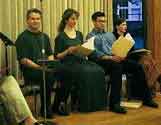 |
||||
| This is what we’d like to do for you. We have chosen for you four of the many strange things that Nathan and Michele had us do (actually we’ve done some pretty odd things on our own, as well.) We’ve divided Act 1 scene 1 of A Dollhouse into four sections. We will read you Section 1 of the original text, and then show you what happened when we took that same text into some odd experimental dimension. Then the original Section 2 followed by the…experimental treatment of that same text, on in increments until we reach the end of Act I. Also, as you can see from your program, we’ve included some other material as well—"bringing together" Nathan and Michele’s work with various small projects that we’ve enjoyed working on recently. [See program below.] |
||||
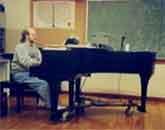 |
||||
| So: Part 1 of Act 1 of A Dollhouse. Nathan is both a musician and an actor. As a musician, he became an expert in the work of Jacques-Dalcroze. Dalcroze developed a way of training musicians with movement and rhythm. This work inspired Nathan to do his doctoral work on the usefulness of training actors with movement and rhythm. So that bringing Nathan here to work with us was a bringing together of our own acting, voice and movement work…with Nathan’s music training—for actors. We have greatly simplified this work for the moment. We are really only working with manipulations of FAST and SLOW. This is enough for us to handle now. We have two sets of Maid-Porter-Nora-and-Torvalds for the two halves of this section. Each set will each show you two contrasting rhythm studies. You will see a fast Nora surrounded by slow characters—and then a slow Nora surrounded by fast characters—by one cast and then the other. Ground rules: they can speak the actual lines, or improvised lines, or gibberish. They have to stay close to the essential dynamics of the text. Reading 1st Part of Act Ii of Ibsen’s A Dollhouse, 1879 |
||||
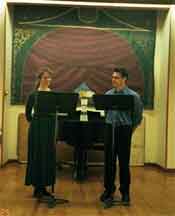 |
||||
| Rhythm Treatment | ||||
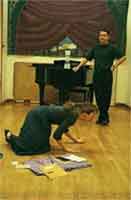  |
||||
Part 2 of Act 1. Michele Cuomo herself "brings together" so many different kinds of work that bringing hers together with ours is a lot of bringing. She came to us last month with  the compelling notion that actors can enrich their work with a "natural-looking" sort of text—like A Dollhouse--by exploring virtually any extreme performance style—by "pushing the envelope," as it were. One of the forms of acting she had us work with was the Italian commedia dell’arte, first popular in the mid-16th century. This improvisational form centered completely on the actors, with no playwright or director—simply stock characters with lazzi or set "bits" to perform around a basic scenario. To create the following piece for you, we used these basic ground rules: each character has a body, walk and sound based on an animal. If you don’t like something, you have to hit someone. If you are hit, you have to fall down. If you want something, you have to chase someone for it. If someone is chasing you, you have to run in a circle. You are to upstage everyone at all times. the compelling notion that actors can enrich their work with a "natural-looking" sort of text—like A Dollhouse--by exploring virtually any extreme performance style—by "pushing the envelope," as it were. One of the forms of acting she had us work with was the Italian commedia dell’arte, first popular in the mid-16th century. This improvisational form centered completely on the actors, with no playwright or director—simply stock characters with lazzi or set "bits" to perform around a basic scenario. To create the following piece for you, we used these basic ground rules: each character has a body, walk and sound based on an animal. If you don’t like something, you have to hit someone. If you are hit, you have to fall down. If you want something, you have to chase someone for it. If someone is chasing you, you have to run in a circle. You are to upstage everyone at all times. |
||||
| We have greatly simplified this for the moment. We are basically working with manipulations of HAVING MACAROONS or NOT HAVING MACAROONS—"macaroons" being an image we’ve taken from the opening of the play, and the dynamic of wanting what someone else has being from the second section, which you are about to hear. Reading 2nd Part of A Dollhouse, Ii Commedia Treatment |
||||
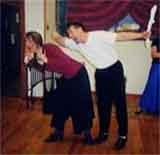 |
||||
| Part 3 of Act 1. Michele and I share a great love of the avant-garde, especially the European avant-garde that developed in response to World War I, and the next two sections of our program reflect that love. More specifically, Michele and I share a conviction which I expressed in a letter to our online discussion group--Stage and Screen--just last week (by the way, this was in response to something that Nathan had written about moving the theatre forward in our time): "I think the next step will never happen until we are able to own the work that took place in this field from pre-WWI to post WWII. All that brilliant work disowned by our contemporary theatre. The work of Edward Gordon Craig in England, Artaud in France, Marinetti in Italy, Meyerhold in Russia, the Bauhaus in Germany--all this work is so delicious and sophisticated, so grounded in the classics, that our contemporary theatre is puerile by comparison. We'll never go forward till we look back on all that." In this context, Michele had us experiment with some of the ideas of Robert Wilson, one of the cornerstones of what avant-garde America can claim. I’ve never been too fond of his work, so I was startled to find that the rehearsal approach Michele showed us was so close to some of our own experiments. Ground rules ala Robert Wilson: each pair of actors chooses a sequence of seven unrelated, meaningless poses. This sequence is then matched with seven exchanges of text—and of course we are using the Dollhouse text. You’ll see each pair twice: first, with the poses and text matching, and then with them staggered—in other words, they have to do all of the poses and say all of the words in order, but not together. Well…you’ll see… Reading 3rd Part of A Dollhouse, Ii Robert Wilson Treatment |
||||
 |
||||
| The 4th and Last Part of Act 1. Michele’s grand and…multi-faceted visit concluded with our foray into Instant Poetry. This is a Dada form, which came out of Zurich during WWI. I have a poem here contributed by Michele, which is by Tristan Tzara, who was one of the caretakers of the Dada movement. In the poem, he himself gives the "ground rules" for how to make a dadaist poem. It is called, "How to Make a Dadaist Poem." Once more, you will hear Ibsen’s original text, and then…what became of it… HOW TO MAKE A DADAIST POEM by Tristan Tzara Take a newspaper Take some scissors. Choose from this paper an article of the length You want to make your poem. Cut out the article. Next carefully cut out each of the words that make up the Article and put them all in the bag. Shake gently. Next take out each cutting one after the other. Copy conscientiously in the order in which they left the bag. The poem will resemble you. And there you are--an infinitely original author of Charming sensibility even though unappreciated By the vulgar herd. Reading 4th Part of A Dollhouse, Ii Instant Poetry Treatment |
||||
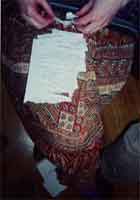 |
||||
| I opened tonight by telling you a little of where the Actors’ Training Project has come from, and you’ve just seen a little of where we are now. As for what is ahead: let me only say that I experience a great paradox in the "Bringing Together" work that we are doing. We are bringing together a range of different skills, a variety of approaches, everything "multi-": multi-disciplinary, multi-faceted, multi-dimensional, multi-directional, multi-layered, on and on…and yet—the end result for me is the experience of singularity. A singular vision, a singular dream, a singular hope for the Actors’ Training Project—a singular belief in its future. I have carried this poem with me on a tattered index card for over twenty years—from 9th century Japan: I have always known that at last I would take this road but yesterday I did not know that it would be today. The path that we are on now has that same surprising, inevitable feeling—and as the poem says: I have always known. |
||||
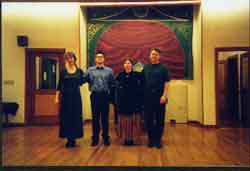 |
||||
| Special Thanks: Nathan Thomas, Ph.D. (Maryland) & Michele Cuomo, MFA (Mississippi) |
||||
| AWARDS CEREMONY |
||||
| PROGRAM: | ||||
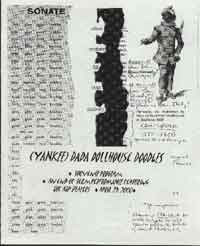 |
||||
| (Yankee) Dada Dollhouse Doodles Actors’ Training Project End-of-Term Recital 15th Anniversary Program Tuesday, April 25, 2000 |
||||
| Opening Remarks………………………………………………………………...…….Lissa Introduction to Rhythm Work…………………………………………………………Lissa |
||||
| Reading 1st Part of Act Ii of Ibsen’s A Dollhouse, 1879.…………… Max, Kathie | ||||
| Rhythm Treatment……………………………….………Kathie, Kattt, Kevin, Max Spring, by Kandinsky, 1912-13…………..………...………………………….Max Twinkle Twinkle, by Lewis Carroll,1865…………………………..………...Kevin Introduction to Commedia Work……………………………………………………..Lissa |
||||
| Reading 2nd Part of A Dollhouse, Ii………………………………......Max, Kathie | ||||
| - Intermission - | ||||
| Introduction to Robert Wilson Work………………………………...………………Lissa | ||||
| Reading 3rd Part of A Dollhouse, Ii…………………………………..Max, Kathie | ||||
| Robert Wilson Treatment…………………...……………Kathie, Kattt, Kevin, Max Reading from T.E. Hulme’s trench diary, Feb. 10, 1915……..……..………..Lissa Reading from Sonata, by Kurt Schwitters, 1923………………... ……..……Lissa Twinkle Twinkle, Carroll…………………………………………..…………..Max Introduction to Instant Poetry, especially How to Make a Dadaist Poem, by Tristan Tzara (d. 1963)……………..…………………………………….......Lissa |
||||
| Reading 4th Part of A Dollhouse, Ii………………………………...…Max, Kathie | ||||
| Instant Poetry Treatment………………..………………..Kathie, Kattt, Kevin, Max Reading from Talking About Legs, by Alfred Lichtenstein, c. 1913..Kevin, Kathie Twinkle Twinkle, Carroll…………………..……………………………..….Kathie Twinkle, Twinkle Little Star, traditional………………………………….…….All Conceived and Directed………………………………………...Lissa Tyler Renaud Players…………….Max Gill, Kevin Morrison, Kattt Sammon, Kathie Schmid |
||||
| © 2001 Lissa Tyler Renaud. All rights reserved. Please share this text—including copyright information—with interested private parties and for educational purposes. But please contact me for permission before you reproduce, translate, transmit, frame or store this in a retrieval system for public use: acttrainproj@earthlink.net. Thank you for your consideration. LTR/ATP A version of this article appeared in the August 2000 issue of Scene4 Magazine. |
||||